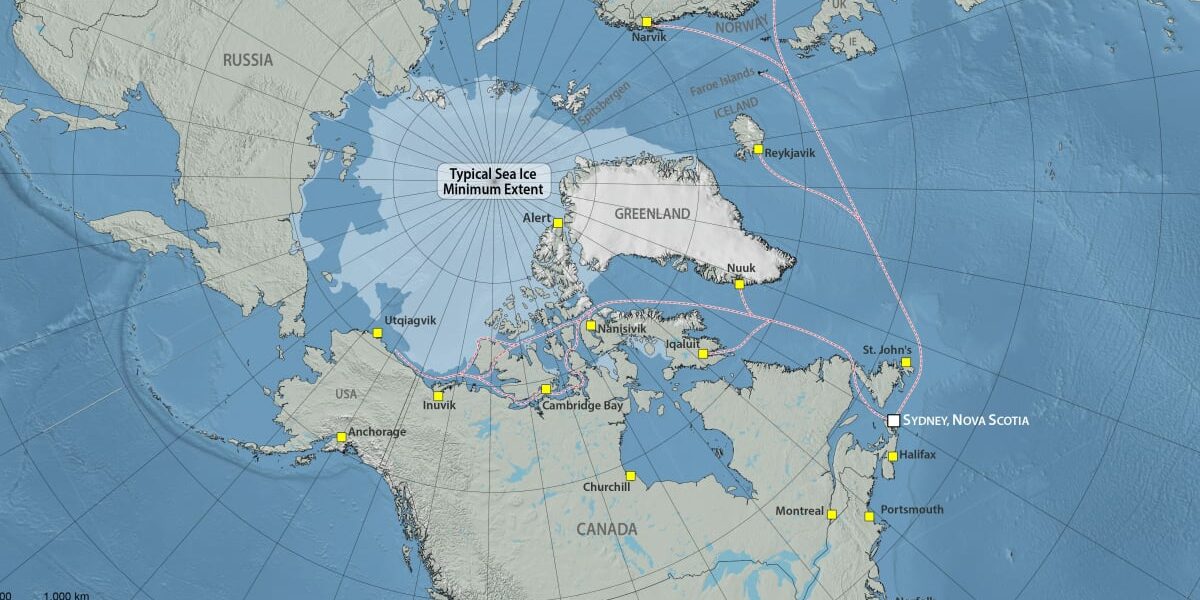Nova Scotia’s Sydney Harbour has joined five other ports ringing the North Atlantic to develop industrial infrastructure to serve both the burgeoning North American offshore wind sector as well as Canada’s naval fleet, under the newly formed Northern Lights Port Alliance.
Announcement of the alliance — which includes ports in Denmark, Norway, Greenland, Iceland, and the Faroe Islands — comes ahead of the North Atlantic Treaty Organization (NATO) Summit this week in The Hague, in the Netherlands, where Arctic security is expected to be high on many nations’ agendas.
“This alliance reflects a new level of Arctic cooperation,” said Albert Barbusci, co-founder of the Sydney Harbour Investment Partners, which was set up to develop the harbour ports that will be part of the alliance, in an interview.
“And it will be truly ‘nation-building’ for Canada in keeping with Prime Minister [Mark Carney’s] and our country’s ambition for a new wave of economic growth in our provinces and territories.”
Barbusci is also CEO of Sydney’s Novaporte wind port, which is in early-stage engineering for development, marshalling and manufacturing turbine blades and towers for major offshore projects off the US and Canadian Atlantic. He said the alliance of ports was focusing on “dual use: civil and defence.”

The aim, he stated, is to create a “strategic Arctic maritime framework across key gateways in Europe and North America [that was in line] with NATO priorities, climate transition goals and global trade resilience.”
“This Northern Lights Ports Alliance reflects a new level of Arctic cooperation,” says Novaporte CEO Albert Barbusci.
Dennis Jul Pedersen, CEO of Denmark’s port of Esberg, said ports were becoming “frontline assets in both economic and geopolitical terms” in the new world order now emerging.
“This alliance strengthens our collective capacity to manage risks, support partners and prepare for the Arctic future. This is a rare opportunity,” said Pedersen, in a statement sent to Canada’s National Observer. “Those who understand the long arc of industrial development and security will see the strategic value [of the Northern Lights Port Alliance].”
The alliance, in a statement, said the strategy, through its timing and scope, signalled “readiness and commercial foresight in the face of increasing competition and climate disruption in the High North.”
Sydney Harbour’s ‘unique potential’
For Sydney Harbour, said Barbusci, there is “unique industrial development potential” given that the former Point Edward naval base — now rebadged as the Point Edward Marine and Industrial Park — neighbours Novaporte.
This makes it “ideal to marry up a wind terminal” for future offshore wind farms off Nova Scotia and a station for polar-class naval vessels to patrol Canadian Arctic waters, he said, adding that the harbour planned to apply for NATO designation.
“Canada is now pivoting away from the US for many reasons — trade and energy particularly — and toward Europe, and this alliance having five European partners can help underpin this,” Barbusci added.
Developing Sydney Harbour, located on Cape Breton Island, to handle offshore wind supply and services with an eye on future naval sector applications, he said, could help galvanize strategy on Canadian defence planning, as the US administration puts the thumbscrews to its northern neighbour to raise NATO spending.

“This would be a big boost to securing Canada’s sovereign access to Arctic sea lanes, including the Northwest Passage,” said Barbusci.
“It would also give our port capabilities with NATO interoperability and rapid force mobility, ensure resilient resupply systems for Arctic and remote northern communities, coordinate long-term marine spatial planning and climate-conscious operations, [and] reduce reliance on vulnerable global chokepoints and contested shipping corridors,” he said.
Canadian ports have been at the centre of discussions led by the Liberal government that could see investment of some $5 billion injected under a “one Canadian economy” strategy to spur diversification of trade and energy away from the US.
Nova Scotia’s Wind West megaproject
Winds rush along the coastlines of the Maritime provinces at speeds similar to those off Northern Europe — at roughly 40 km/h — where offshore wind farms have been generating power to the grid for over 30 years and have led to development of a sector employing over 300,000 people.
Canada’s Atlantic Economic Council said last year that offshore wind off Nova Scotia could become a $7-billion market by 2030, creating an initial 5,000 jobs amid other benefits for regional economies.
Nova Scotia is set to hold its first auction, where waters would be leased to developers to harness a first 5,000 megawatts (MW) of energy, before the end of 2025.
But under the aegis of making Canada an “energy superpower,” Premier Tim Houston has pitched the province’s giant 40,000 MW Wind West project to Carney as a means of meeting 27 per cent of Canada’s total energy demand.




